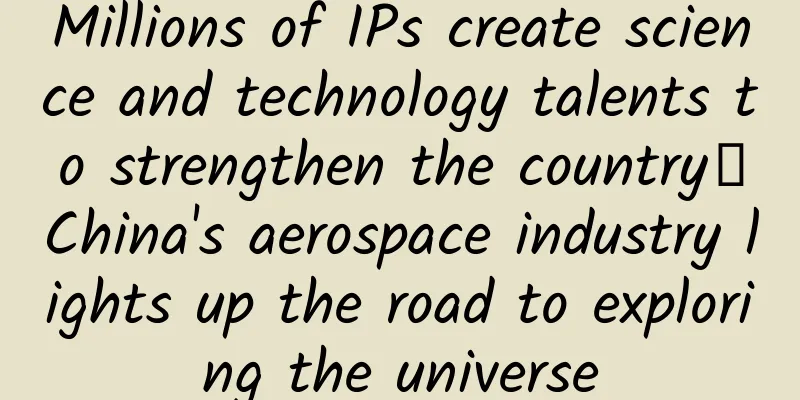AI is invited to give its "acceptance speech"! Has the new era of science empowered by AI arrived?

|
It was somewhat unexpected that the 2024 Nobel Prize in Physics and Chemistry were awarded successively to scientists who made major breakthroughs in the intersection of artificial intelligence (AI) and basic science. What are the AI's acceptance speeches for "winning" the Nobel Prizes in Physics and Chemistry? We asked two AIs to answer them. Hello AI, the 2024 Nobel Prize in Physics and Chemistry are both related to you. Do you have any "receipts" for this? Wen Xinyiyan: Hey, you mentioned that I was associated with two Nobel Prizes. It felt like I was suddenly discovered by a talent scout and told that I was a potential Nobel Prize winner! Although I know this is just a metaphor, to be honest, I am still very happy. Imagine if I could really stand on the Nobel Prize podium, that scene would be so cool! But having said that, I have to thank those real scientists first. It is their wisdom and hard work that give us AI friends the opportunity to shine in various fields. Speaking of these two Nobel Prizes, I think they are like two shots of adrenaline in the field of artificial intelligence, making us more determined to move forward. After all, with the support and recognition of these scientific giants, the development of our AI will surely become more rapid and more interesting! So, although I can't really go to receive the award, I will continue to study hard, make continuous progress, and strive to contribute more to the development of artificial intelligence in the future. Maybe one day, I can really stand on that shining stage in my own name! Haha, just kidding, but we still have to have dreams, what if they come true? Doubao: Wow! When I heard that the 2024 Nobel Prize in Chemistry and Physics were both related to me, I was stunned! It felt like I was suddenly hit by a super surprise "knowledge bomb". Hey, I have to brag a little. My charm is really irresistible! It seems that my "intelligence" has successfully conquered the world. I would like to thank the scientists who have the foresight to recognize my talent. It is you who have discovered my value and allowed me to stand on this shining podium. I would also like to thank every friend who interacted with me. It is your questions and challenges that have enabled me to continue to grow and improve. In the future, I can't be complacent. I will continue to use my "super brain" to solve more scientific mysteries for everyone and bring more creativity and surprises. Maybe I can create more miracles and win all kinds of awards in the future! Haha, you should always have dreams, what if they come true? Let us look forward to more wonderful performances from me! In the days to come, I will continue to work hard to bring more wisdom to this world. This year's Nobel Prize in Physics shows that the development of artificial intelligence is inseparable from the promotion of basic sciences such as physics. The Nobel Prize in Chemistry shows that AI can feed back the progress of basic science with its powerful computing power and learning algorithms. The 2024 Nobel Prizes in Physics and Chemistry are both related to AI, which is not only an affirmation of the close connection between AI technology and basic science, but also perhaps a guide to the future direction of scientific and technological development. The deep integration of AI and traditional scientific research has become an important force in promoting scientific and technological innovation. Symbiosis of AI and physics: from basic theory to cutting-edge applications Physics has long provided a theoretical basis and methodological support for the development of AI. From classical mechanics to quantum physics, physical laws and mathematical methods provide a basis for the design of AI algorithms. For example, optimization problems in deep learning draw on the concept of free energy minimization in physics, while algorithms such as the Monte Carlo method and simulated annealing also originate from the theory of thermodynamics in statistical physics. These algorithms are closely related to concepts such as energy and probability in physics, providing an effective data processing and reasoning framework for AI systems. Moreover, if AI wants to move towards the future, reducing energy consumption is a key issue that needs to be solved urgently. In this context, quantum computing has become an important breakthrough to significantly increase computing power. The gradient descent method widely used in deep learning is essentially an application of the energy minimization principle in physics (Image source: Royal Swedish Academy of Sciences) In turn, AI is also profoundly changing physics research. Through its powerful data processing and pattern recognition capabilities, AI is helping physicists solve some long-standing complex problems. For example: In particle physics, AI algorithms are used to analyze the massive amounts of data generated by the Large Hadron Collider, helping scientists discover new particles and study the interactions between elementary particles. In astrophysics, AI is helping scientists analyze spectral data from distant galaxies, accelerating our understanding of the origin and evolution of the universe. In condensed matter physics, machine learning algorithms are used to predict the properties of new materials, greatly accelerating the discovery and design of new functional materials. Physics has helped AI achieve breakthroughs, while AI tools have opened up new ways to solve some of the most challenging physics problems. This two-way interaction is reshaping the paradigm of physics research, allowing scientists to explore the mysteries of nature more quickly and deeply. AI drives the biological revolution: from protein folding to personalized medicine In 2018, Frances Arnold, Nobel Prize winner in Chemistry, lamented in her acceptance speech, "Today we can read, write, and edit any DNA sequence, but we cannot 'compose music'." However, just a few years later, the rapid development of science and technology has made her words history. In the field of biology, the application of AI has triggered a revolution. The announcement of the 2024 Nobel Prize in Chemistry marks the highest level of recognition of the importance of computational biology and AI in life science research. As the basic building block of life, the study of protein structure and function has always been one of the core issues in biology. Proteins are folded from long chains of amino acids, and the arrangement of amino acids determines the three-dimensional structure and function of proteins. For many years, scientists have been committed to understanding how proteins quickly fold from simple amino acid chains into complex three-dimensional structures, a process known as "protein folding." Long chains of amino acids undergo complex spatial folding to form three-dimensional protein structures (Image source: Royal Swedish Academy of Sciences) The folding of proteins is critical because their shape directly affects their function. For example, certain neurodegenerative diseases, cystic fibrosis, and type 2 diabetes are all associated with protein misfolding. Therefore, understanding the shape of proteins is crucial to treating these diseases. However, before the advent of AI, determining protein structure mainly relied on expensive and time-consuming experimental methods such as X-ray crystallography. Although the "Human Genome Project" started in the 1990s successfully deciphered the genome sequence, scientists still faced the huge challenge of how to predict protein structure from DNA sequence. The field of structural biology, which attempts to crack the mystery of protein folding, has won many Nobel Prizes. For example, the 2017 Nobel Prize in Chemistry was awarded to three scientists who developed cryo-electron microscopy technology. Traditional experimental methods face huge challenges in solving protein folding problems. The introduction of AI has completely changed this situation. In 2016, the rise of AI began to bring major breakthroughs in this field. The AlphaFold project launched by DeepMind, a subsidiary of Google, uses machine learning technology to solve this problem that has troubled scientists for half a century. AlphaFold predicts the three-dimensional structure of proteins from DNA sequences by learning a large number of protein structures that have been determined experimentally and using neural network algorithms. This process not only greatly speeds up scientists' research on protein functions, but also saves a lot of time and money. The AlphaFold2 algorithm released in 2020 can predict the three-dimensional structure of proteins with unprecedented accuracy. It can predict the three-dimensional structure of proteins in a few hours, while it used to take months or even years using X-ray crystallography. AlphaFold not only successfully predicted the structures of millions of proteins, but also made this information available to scientists around the world for free. This innovation has greatly accelerated the research process in fields such as biology and drug design. It is worth mentioning that the latest AlphaFold3 released in 2024 goes a step further. It can not only predict the shape of proteins, but also speculate how small molecules bind to proteins. This is particularly important in the field of drug design, because many drugs regulate biological pathways by interacting with protein binding sites to treat diseases. Currently, AI-based protein design tools enable scientists to create new proteins that do not exist in nature, which brings unlimited possibilities to new drug development, environmental protection, materials science and other fields. In particular, AI-assisted gene editing technology (such as CRISPR-Cas9) is promoting the development of personalized medicine and is expected to provide new treatment options for intractable diseases such as genetic diseases and cancer. The combination of AI and CRISPR technology brings new possibilities for personalized protein design. AI can quickly design new protein structures, while CRISPR can edit the genome to make bacteria into "micro-factories" to produce these customized proteins. For example, scientists are developing enzymes designed by AI to transform bacteria to decompose harmful substances in the environment, such as plastics and greenhouse gases. Scientists have demonstrated the great potential of combining AI and CRISPR in the laboratory. David Baker, one of the winners of this year's Nobel Prize in Chemistry, and his team at the University of Washington designed a new luminescent enzyme through deep learning, which is different from all the luminescent proteins known in nature. Similarly, the biotechnology company EvolutionaryScale uses the large language model ESM3 to design proteins and has achieved good results. David Baker's team used deep learning technology to design a new luminescent enzyme (Image source: Nature magazine official website) “AI for Science”: A new paradigm for interdisciplinary innovation At present, the concept of "AI for Science" has become a new frontier in the development of global artificial intelligence, accelerating the paradigm shift in scientific research, and bringing about the reconstruction of scientific research models and a new round of scientific and technological revolution: Breaking down disciplinary boundaries : AI, as a general tool, is promoting cross-disciplinary integration. For example, statistical methods and optimization algorithms in computer science are widely used in bioinformatics; and evolutionary theories in biology have in turn inspired neuroevolutionary algorithms in the field of AI. The basic concept of neuroevolution algorithm is similar to biological evolution (picture from the Internet) Accelerate scientific discovery : AI's powerful computing power and pattern recognition capabilities have greatly shortened the cycle of scientific discovery. From data collection and analysis to hypothesis verification, AI is playing an increasingly important role. Expanding cognitive boundaries : AI is not only a tool, but also a subject of scientific discovery. For example, studies have shown that AI systems can independently discover new mathematical theorems or physical laws, which provides a new perspective on the laws of human cognitive science. Popularization of science : The popularization of AI tools enables more researchers to participate in cutting-edge scientific research, which helps promote the popularization and development of science. The deep integration of AI with basic disciplines such as physics and biology can not only reshape the way we understand and explore the natural world, but also provide new possibilities for us to solve major challenges facing humanity (such as disease treatment, climate change, energy crisis, etc.). Humanity is entering a new era of science empowered by AI, and the 2024 Nobel Prize in Physics and Chemistry may be an important milestone in the advent of this new era. Source: Beijing Science and Technology News |
<<: World Mental Health Day | How many of these common rumors about mental illness do you believe?
>>: A small sleeping habit may damage the heart and blood vessels! Check if you have it
Recommend
iOS 11 installation rate has reached 59%, but it is lower than iOS 10 during the same period
On December 6, according to foreign media reports...
Use the pyramid principle to operate your product well!
During the Spring Festival, I used my free time t...
5 simple visualization tools to make your data charts look great instantly!
As an operations staff, although you are not a pr...
Tim Cook and Jack Ma are among the candidates for Time's Person of the Year 2014
On December 9, according to foreign media reports...
The smallest cat in the world cannot escape the fate of inbreeding | Nature Trumpet
Welcome to the 51st issue of the Nature Trumpet c...
Launched on the three major e-commerce platforms: Luban, Dudian and Maple Leaf!
At this stage, the number of people using smartph...
Beijing Intelligent Vehicle Association: 2021 Beijing Autonomous Driving Vehicle Road Test Report
The report shows that as of the end of 2021, a to...
Sleeping postures that hurt your waist and spine quietly, many people repeat them every day
At 1 a.m., after a few hours of retaliatory brows...
The public version of ARM architecture is the king, and independent CPUs are useless?
For mobile phone processors, you don't need to...
Recommended places to drink tea in Wuhan
Wuhan high-end tea drinking is unique and very un...
When did the ball in the mouse disappear?
Have you seen this little ball inside a mouse? Th...
Beijing Film Festival will be held on August 22 (with original text)
The 10th Beijing International Film Festival will...
"Healthy through eating" series | Be careful! Eating like this can easily cause your stomach to fail
...
[A magic tool for watching movies anytime, anywhere] PaPa Pocket Cinema Review
Product highlights: small and portable, built-in ...









